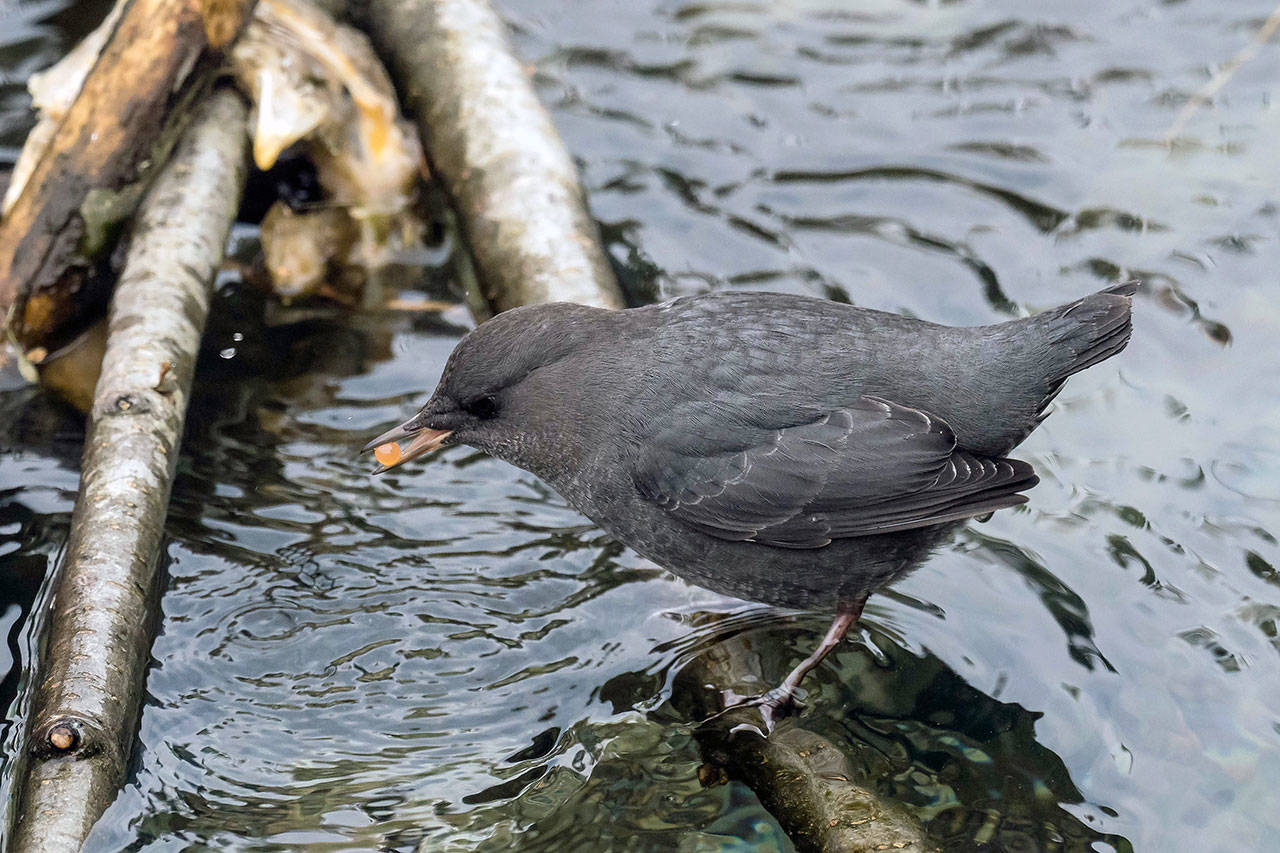By Dianna Moore
Grays Harbor Audubon Society
This article is a hats off to my friend Suzanne who absolutely loves American Dippers and has been patiently waiting for me to do an article on them. I had to wait until photographer Gregg Thompson gave me a good enough photo to justify the coverage and I believe the photo above qualifies.
General Description: America Dippers are unique birds of fast-moving water and are North America’s only aquatic songbird. I used to know them by their old name of Water Ouzel, a name I much prefer to Dipper. They are a robin-sized bird with all-over gray plumage with slightly browner heads. They are stocky with dark eyes and beaks and have lighter gray legs and feet. Their upper eyelids are white-feathered, showing that flash when they blink, and they constantly bob up and down as they move over the rocks and through the water. Both sexes are approximately 5.5 to eight inches in length, and weigh about 1.5 to 2.4 ounces. Their tail is short and carried cocked up in the air.
Habitat: These birds spend most of their time in swiftly flowing, cold, and very clean streams within forested zones, not unlike salmon. They can be found from alpine zones down to sea level as long as there are suitable streams. In winter they can sometimes show up in unusual places, but will always be found in or near water. To survive cold winter waters, they have a low metabolic rate, extra oxygen-carrying capacity in their blood, and a thick coat of feathers. They also molt their wing and tail feathers all at once in late summer, during which time they are flightless, a similarity they share with ducks.
Behavior: Unlike other birds that bob as they walk, Dippers move their entire body up and down. It is thought that they bob as well as flashing their white eyelids as a visual way to communicate in the rushing noise of the stream. They spend their time walking on the bottom of a stream, heads submerged, catching their food by turning over rocks or snatching prey off the surface of the water as it boils past them. They use their wings to “fly” through the water under the surface or sometimes fly through waterfalls. They are usually solitary and will defend their territories throughout the year. Their calls and songs are loud to compete with the noise of the rushing water.
Diet: The diet of the American Dipper is mostly aquatic insects found under rocks on the bottom of streams or floating by in the rushing stream. They also eat small fish, dragonflies, worms, and flying insects. They are often found in salmon-spawning areas as they love salmon eggs.
Nesting: Dippers are usually monogamous but a male may have two nest sites and a female in each one. The traditional location of the nest is six to 20 feet off the surface of the water to guard against predators and flooding. It may be on a cliff ledge or behind a waterfall, but more commonly it is now located under a bridge. The nest is a large, mossy dome that receives spray from the nearby water, keeping the moss alive. It is an outer shell of moss and grass with a low entrance facing the water. The nest cup is grass, leaves, and strips of bark. The female incubates four to five eggs for 13 to 17 days, while the male provides food. After the young hatch, the female broods them for about a week then joins the male in finding food for them. They young leave the nest after about 24 to 26 days; they are able to swim and dive immediately after leaving the nest. The parents often split the brood and continue to feed the young for up to 24 days after leaving the nest.
Migration: American Dippers are year-round residents, only moving to lower elevations if their stream freezes over.
Conservation Status: Not much is known about the population of these birds as they generally live at higher elevations. We do know that what is good for salmonids is good for Dippers; cold, clean water is foremost in the needs of both creatures. New bridges are good for the Dippers, giving them new habitat and nest sites. Dippers are good indicators of stream health. Deforestation and industrial and agricultural pollution increase stream temperature and the amount of silt in the water, both reduce the amount of prey in the streams.
When and Where to Find on Grays Harbor: In winter the American Dipper tends to stay at lower elevations where the water is ice-free. They have been seen at Lake Sylvia, Cloquallum Creek, and in Olympic National Park. Look for the fast-running streams and watch for a dark bird bobbing along as though in time to his own music.


